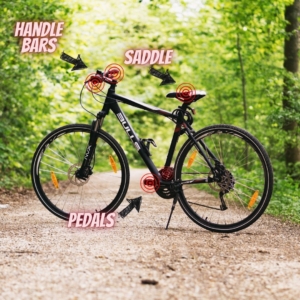ARE YOU BIKING THIS SUMMER?
There are 3 important areas on your bike that need to be adjusted before you embark on your summer adventures.
Moves You family, summer is here and what better way to stay active than biking and exploring the outdoors. We want to make sure that you stay safe and enjoy this activity injury-free!
Year after year, we get patients that come into our clinic with knee, hip, and back pain after an “awesome” biking session. They did not do anything different; they biked the same areas and the same amount of time. So, where did it go wrong?…
What do all these patients have in common?… Their bikes! Yes, you heard that right. We found that the common factor was related to the incorrect adjustment of bike accessories. This led to poor body positioning, while biking.
Here at Moves You, we care about injury prevention, and we want to give you a quick rundown on how to adjust your bike for a more comfortable and efficient ride.
The 3 important points of contact that require adjustment are the saddle, handlebars, and pedals.

Saddle (bike seat)
Your comfort on a long ride will be determined by your saddle. Saddles vary and are gender based. Men and women tend to use these saddles interchangeably. After all, bike-fitting is all about finding what is comfortable for you. A bike seat also requires some tweaking once it is on the bike, and this depends on your body type. Always make sure to adjust the height, tilt, and the front-back
positioning.
To determine a good height for your saddle, place your heel on the pedal and pedal backwards to reach the six o’clock position. Your knee should be completely straight. If your knee is still bent, you need to increase the height; adjust in small increments each time. If your heel loses contact with the pedal, you need to lower the saddle.
Most riders also look for a saddle tilt (angle) that allows them to apply strong consistent pressure to the pedals through the pedal stroke. In most cases this means your saddle should be at a neutral angle. So, when you’re sitting on the middle portion you are not sliding forwards on the nose or backwards off the rear of the saddle.
The front-back positioning relates to the distance between your seat and the handlebars of the bike seat. This positioning can affect the muscle groups that get activated through your pedal stroke. It also affects the amount of pressure applied on your knees. By moving your saddle backwards, you will increase hamstring engagement, whereas moving your saddle forward will put more load on your quadriceps. For this particular fitting you can sit on the bicycle with the pedals at 9 o’clock and 3 o’clock (neutral position). Next, hold a plumb line starting at the kneecap. The other end of this line should intersect the pedal spindle. Your kneecap should not be past your toes.
Handlebars
While adjusting your bike, take a moment to tweak the handlebar as well. Proper adjustment of this area can help improve hand comfort and reduce numbness. Generally, cyclist look to have an angle between the torso and the upper arm that is around 90 degrees. Make sure you have a slight bend in the elbows to maximize comfort and control. For those who like to ride in an upright position, the angle at the shoulder will be less than 90 degrees.
To make sure your handlebar is in a comfortable position, put both hands on the bars, at waist level. Usually, a comfortable handlebar will closely align with your armpits.
When adjusting the handlebar, it is important that you rotate the bar to an angle that is comfortable for you. In this case there is no standard measurement to determine correct positioning as this is solely based on what type of riding you are planning to do and the angle that is comfortable for you. This will vary from person to person.
Pedals
Let’s not forget to adjust the pedals in your bike. This component often gets overlooked and it tends to be the root cause of some injuries or discomfort in cyclists. Having good contact and proper positioning of your feet on the pedals will help to ensure maximum pedal power and efficiency. Your bicycle seat determines the position of your foot. If properly fitted, your feet will be in contact with the pedals throughout your full range of motion.
For proper positioning make sure that the ball of your foot is just in front of the pedal spindle. The pedal should support the back section of the meaty part of the ball of the foot. This placement allows the rider to stay balanced when standing on the pedals. If your foot is further back on the pedal, you will lose reach and power. If your foot is too far forward, it will place undue pressure on your toes, potentially causing injury.
Now that you know how to correctly fit your bike, let us prevent those injuries that would keep you from enjoying your summer.
Moves You family – stay safe, stay healthy and keep MOVING!
![]()



